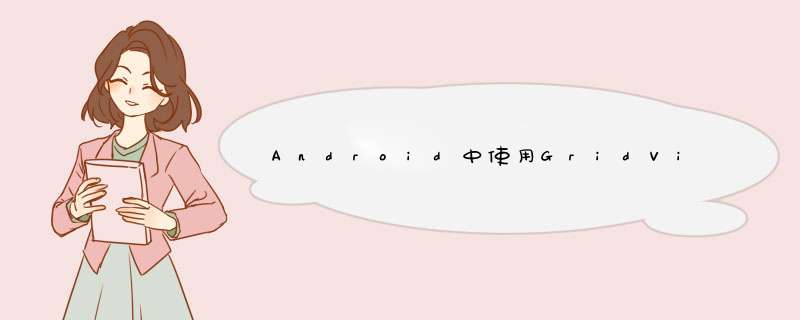
我们在手机上查看相册时,首先看到的是网格状的图片展示界面,然后我们选择想要欣赏的照片点击进入,这样就可以全屏观看该照片,并且可以通过左右滑动来切换照片。如下图的显示效果:
实现Activity之间的跳转以及照片标记位置的传递需要用到intent,并分别使用putExtra以及getExtra,传入和获取照片的标记位置。
(关于intent,后期会有专门博文介绍具体使用,请大家持续关注哦)
下面我们开始功能的实现:
第一步:Layout中建立首页GrIDVIEw布局grID_layout.xml文件:
<?xml version="1.0" enCoding="utf-8"?><linearLayout xmlns:androID="http://schemas.androID.com/apk/res/androID" androID:orIEntation="vertical" androID:layout_wIDth="match_parent" androID:layout_height="match_parent"> <GrIDVIEw androID:ID="@+ID/gv" androID:layout_wIDth="match_parent" androID:layout_height="wrap_content" androID:numColumns="auto_fit" androID:verticalSpacing="10dp" androID:gravity="center" androID:horizontalSpacing="10dp"></GrIDVIEw></linearLayout>
第二步:Layout中建立GrIDVIEw布局中每个item的布局grIDitem_layout.xml文件:
<?xml version="1.0" enCoding="utf-8"?><linearLayout xmlns:androID="http://schemas.androID.com/apk/res/androID" xmlns:app="http://schemas.androID.com/apk/res-auto" androID:orIEntation="vertical" androID:layout_wIDth="wrap_content" androID:layout_height="wrap_content" androID:gravity="center"> <ImageVIEw androID:layout_wIDth="wrap_content" androID:layout_height="wrap_content" androID:adjustVIEwBounds="true" androID:maxWIDth="280dp" androID:maxHeight="280dp" androID:src="@mipmap/a1" androID:ID="@+ID/imageVIEw" /></linearLayout>
这里的设置需要根据实际展示图片的宽度以及要展示的容器(手机)分辨率来设置等比例缩放,避免排版混乱的情况出现。
第三步:Layout中建立图片展示界面(包含导航圆点)布局activity_main.xml文件:
这里主布局使用FrameLayout,切换实现布局使用ImageSwitcher,导航圆点使用linearlayout实现(可通过配置文件实现):
<?xml version="1.0" enCoding="utf-8"?><FrameLayout xmlns:androID="http://schemas.androID.com/apk/res/androID" xmlns:tools="http://schemas.androID.com/tools" androID:ID="@+ID/activity_main" androID:layout_wIDth="match_parent" androID:layout_height="match_parent" tools:context="com.example.administrator.switcher.MainActivity"> <ImageSwitcher androID:layout_wIDth="match_parent" androID:layout_height="match_parent" androID:ID="@+ID/is"> </ImageSwitcher> <linearLayout androID:ID="@+ID/point_layout" androID:layout_wIDth="match_parent" androID:layout_height="wrap_content" androID:layout_gravity="bottom" androID:orIEntation="horizontal"> <ImageVIEw androID:layout_wIDth="wrap_content" androID:layout_height="wrap_content" androID:layout_weight="1" androID:src="@mipmap/default_holo"/> <ImageVIEw androID:layout_wIDth="wrap_content" androID:layout_height="wrap_content" androID:layout_weight="1" androID:src="@mipmap/default_holo"/> <ImageVIEw androID:layout_wIDth="wrap_content" androID:layout_height="wrap_content" androID:layout_weight="1" androID:src="@mipmap/default_holo"/> <ImageVIEw androID:layout_wIDth="wrap_content" androID:layout_height="wrap_content" androID:layout_weight="1" androID:src="@mipmap/default_holo"/> </linearLayout></FrameLayout>
第四步:Java中Activity的实现代码,首页GrIDVIEw的实现代码GrIDActivity.java:
本次自定义适配器中getvIEw方法已经优化:
import androID.content.Intent;import androID.support.v7.app.AppCompatActivity;import androID.os.Bundle;import androID.vIEw.VIEw;import androID.vIEw.VIEwGroup;import androID.Widget.AdapterVIEw;import androID.Widget.BaseAdapter;import androID.Widget.GrIDVIEw;import androID.Widget.ImageVIEw;public class GrIDActivity extends AppCompatActivity { private GrIDVIEw gv; int[] images={R.mipmap.a1,R.mipmap.a2,R.mipmap.a3,R.mipmap.a4}; @OverrIDe protected voID onCreate(Bundle savedInstanceState) { super.onCreate(savedInstanceState); setContentVIEw(R.layout.grID_layout); gv= (GrIDVIEw) findVIEwByID(R.ID.gv); gv.setAdapter(new MyAdapter()); //设置单击GrIDVIEw中每个item的单击事件 gv.setonItemClickListener(new AdapterVIEw.OnItemClickListener() { @OverrIDe public voID onItemClick(AdapterVIEw<?> parent,VIEw vIEw,int position,long ID) { //使用intend获取要交互的Activity,也就是将要跳转的界面 Intent intent = new Intent(GrIDActivity.this,MainActivity.class); //通过intent的putExtra方法获取点击图片的下标位置(用于Activity之间数据传输) intent.putExtra("select",position); //启动要交互的Activity(通过传入包含该Activity的intent) startActivity(intent); } }); } class MyAdapter extends BaseAdapter{ @OverrIDe public int getCount() { return images.length; } @OverrIDe public Object getItem(int position) { return images[position]; } @OverrIDe public long getItemID(int position) { return position; } @OverrIDe public VIEw getVIEw(int position,VIEw convertVIEw,VIEwGroup parent) { VIEwHolder vh; if(convertVIEw==null){ convertVIEw=getLayoutInflater().inflate(R.layout.grIDitem_layout,null); vh= new VIEwHolder(); vh.iv= (ImageVIEw) convertVIEw.findVIEwByID(R.ID.imageVIEw); convertVIEw.setTag(vh); } vh= (VIEwHolder) convertVIEw.getTag(); vh.iv.setimageResource(images[position]); return convertVIEw; } class VIEwHolder{ ImageVIEw iv; } }}第五步:Java中Activity的实现代码,跳转后的ImageSwicher的实现代码MainActivity.java:
import androID.content.Intent;import androID.support.v7.app.AppCompatActivity;import androID.os.Bundle;import androID.vIEw.MotionEvent;import androID.vIEw.VIEw;import androID.Widget.ImageSwitcher;import androID.Widget.ImageVIEw;import androID.Widget.linearLayout;import androID.Widget.VIEwSwitcher;import java.util.ArrayList;/** * Created by panchengjia on 2016/12/05. */public class MainActivity extends AppCompatActivity implements VIEwSwitcher.VIEwFactory,VIEw.OntouchListener{ private ImageSwitcher is;//声明ImageSwitcher布局 private linearLayout point_layout;//声明导航圆点的布局 //图片ID数组(需要与GrIDActivity中的图片资源数组一一对应) int[] images={R.mipmap.a1,R.mipmap.a4}; //实例化存储导航圆点的集合 ArrayList<ImageVIEw> points = new ArrayList<>(); int index;//声明index,记录图片ID数组下标 float startX;//手指接触屏幕时X的坐标(演示左右滑动) float endX;//手指离开屏幕时的坐标(演示左右滑动) @OverrIDe protected voID onCreate(Bundle savedInstanceState) { super.onCreate(savedInstanceState); setContentVIEw(R.layout.activity_main); //获取GrIDActivity中设置的intent Intent intent = getIntent(); //获取GrIDActivity中得到的图片下标,并随意设置默认值 index = intent.getIntExtra("select",0); is = (ImageSwitcher) findVIEwByID(R.ID.is); is.setFactory(this);//通过工厂实现ImageSwitcher initpoint(); is.setontouchListener(this);//设置触摸事件 } //初始化导航圆点的方法 private voID initpoint() { point_layout= (linearLayout) findVIEwByID(R.ID.point_layout); int count = point_layout.getChildCount();//获取布局中圆点数量 for(int i =0;i<count;i++){ //将布局中的圆点加入到圆点集合中 points.add((ImageVIEw) point_layout.getChildAt(i)); } //设置GrIDActivity中选中图片对应的圆点状态为触摸实心状态 points.get(index).setimageResource(R.mipmap.touched_holo); } //设选中图片对应的导航原点的状态 public voID setimagebackground(int selectimage) { for(int i=0;i<points.size();i++){ //如果选中图片的下标等于圆点集合中下标的ID,则改变圆点状态 if(i==selectimage){ points.get(i).setimageResource(R.mipmap.touched_holo); }else{ points.get(i).setimageResource(R.mipmap.default_holo); } } } //实现VIEwFactory的方法实例化imageVIEw(这里未设置ImageVIEw的属性) @OverrIDe public VIEw makeVIEw() { //实例化一个用于切换的ImageVIEw视图 ImageVIEw iv = new ImageVIEw(this); iv.setScaleType(ImageVIEw.ScaleType.FIT_XY); //默认展示的第一个视图为images[index](主页面跳转过来的图片) iv.setimageResource(images[index]); return iv; } @OverrIDe public boolean ontouch(VIEw v,MotionEvent event) { //按下屏幕 if(event.getAction()==MotionEvent.ACTION_DOWN){ startX=event.getX();//获取按下屏幕时X轴的坐标 //手指抬起 }else if (event.getAction()==MotionEvent.ACTION_UP){ endX=event.getX(); //判断结束坐标大于起始坐标则为下一张(为避免误 *** 作,设置30的判断区间) if(startX-endX>30){ //三目运算判断当前图片已经为最后一张,则从头开始 index = index+1<images.length?++index:0; //使用系统自带的切换出入动画效果(也可以像VIEwFlipper中一样自定义动画效果) is.setInAnimation(this,androID.R.anim.fade_in); is.setoutAnimation(this,androID.R.anim.fade_out); //判断结束坐标小于于起始坐标则为上一张(为避免误 *** 作,设置30的判断区间) }else if(endX-startX>30){ //三目运算判断当前图片已经为第一张,则上一张为数组内最后一张图片 index = index-1>=0?--index:images.length-1; is.setInAnimation(this,androID.R.anim.fade_out); } //设置ImageSwitcher的图片资源 is.setimageResource(images[index]); //调用方法设置圆点对应状态 setimagebackground(index); } return true; }}本次代码展示到这里就结束了,按照前文所讲,大家可以尝试多种实现方法,本次使用到的intent,后面会有详细讲述,也希望大家多多支持编程小技巧。
总结以上是内存溢出为你收集整理的Android中使用GridView和ImageViewSwitcher实现电子相册简单功能实例全部内容,希望文章能够帮你解决Android中使用GridView和ImageViewSwitcher实现电子相册简单功能实例所遇到的程序开发问题。
如果觉得内存溢出网站内容还不错,欢迎将内存溢出网站推荐给程序员好友。
欢迎分享,转载请注明来源:内存溢出

 微信扫一扫
微信扫一扫
 支付宝扫一扫
支付宝扫一扫
评论列表(0条)